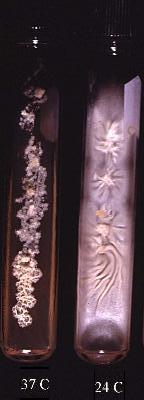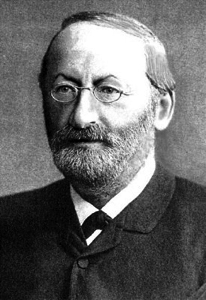 Once again I’m down to the last minute, trying to juggle too many things and almost missing this month’s “Giant’s Shoulders” blog carnival. Almost.
Once again I’m down to the last minute, trying to juggle too many things and almost missing this month’s “Giant’s Shoulders” blog carnival. Almost.
Today we go once again all the way back to the Victorian era, to see that if you thought bacterial taxonomy was difficult now, imagine what it was like over 130 years ago:
Cohn F:”Untersuchungen über Bacterien”; Beiträge zur Biologie der Pflanzen; 1875, vol 1; pp 127-222
(Or “Researches regarding Bacteria”, in “Contributions towards the Biology of Plants”)
This paper is an overview of the problem of categorizing bacteria among the types of living things, and makes some early suggestions. I don’t think it’ll spoil too much of the punchline to point out that not only is the journal about the biology of plants, but the paper also starts out with Cohn describing how he came to work at the “plant physiological institute”. Cohn’s assertion that bacteria are definitely a form of plant actually stuck for at least another three-quarters of a century or so – I have a copy of a 1945 book on bacteriology that actually has a short discussion on why bacteria are categorized as plants rather than animals (or “animalcules”, even). That’s only part of what’s interesting about this paper, though.
Cohn discusses a number of problems with the nature of bacteria in his time. For one thing, he says there had been little real effort to even come up with a coherent scheme for classifying bacteria at that point. He does mention one previous attempt to come up with a system, but on the whole it seems everyone is just coming up with terminology on the fly – even taking Pasteur himself to task for throwing around a variety of terms related to microbes without distinguishing what the terms actually refer to. The reason for this, really, is just that figuring out pretty much anything in detail about bacteria was a seriously difficult problem at the time. Cohn explains why; how it is really impossible to make out more than general shape and size from microscopic examination, and how the lack of any detectable sexual reproduction makes it impossible to do positively identify members of the same species. In fact, even very obvious differences in appearance might not be definitive. It was suspected (and later demonstrated) that some of what appeared to be completely different fungi were actually just different life-stages of the same fungus. (Hopefully you can see the picture at upper right, with the bacteria/yeast-like growth on one tube and the obvious and very different fuzzy mold-type growth on the other. Both are actually the fungus Blastomyces dermitiditis.) Just as some of Cohn’s contemporaries considered that perhaps all molds and yeasts were really just different stages of life of the same organism, perhaps the same might also be true of bacteria?
Cohn does, after all, promote the notion of bacteria as a type of fungus. You may even remember an old word for bacteria: Schizomycetes, that is “fission-fungi” (that is, fungi that reproduce by splitting in half rather than producing spores). This makes sense if you consider that bacteria are more like plants and algae than animals, and fungi were considered to be plants that lacked chlorophyll. Although lamenting that it was not feasible to really separate out individual bacteria to determine whether they ever changed form – this was still three years before Joseph Lister actually did so – Cohn unwaveringly felt that bacteria were in fact made up of several different genera and species, and set out an early attempt at classification.
Once again, Our Friend the American Society for Microbiology hosts a translation of this paper, complete with a couple of paragraphs of more modern editorial commentary at the end. It’s well worth a look.
 Unfortunately, I don’t think Ferdinand Cohn’s hairstyle is nearly as spiffy as Eduard Buchner’s cool “Colonel Sanders Guest Stars on Miami Vice” look. I think he looks kind of like a slightly-better-fed Sigmund Freud with a bad comb-over. But that’s just me.
Unfortunately, I don’t think Ferdinand Cohn’s hairstyle is nearly as spiffy as Eduard Buchner’s cool “Colonel Sanders Guest Stars on Miami Vice” look. I think he looks kind of like a slightly-better-fed Sigmund Freud with a bad comb-over. But that’s just me.